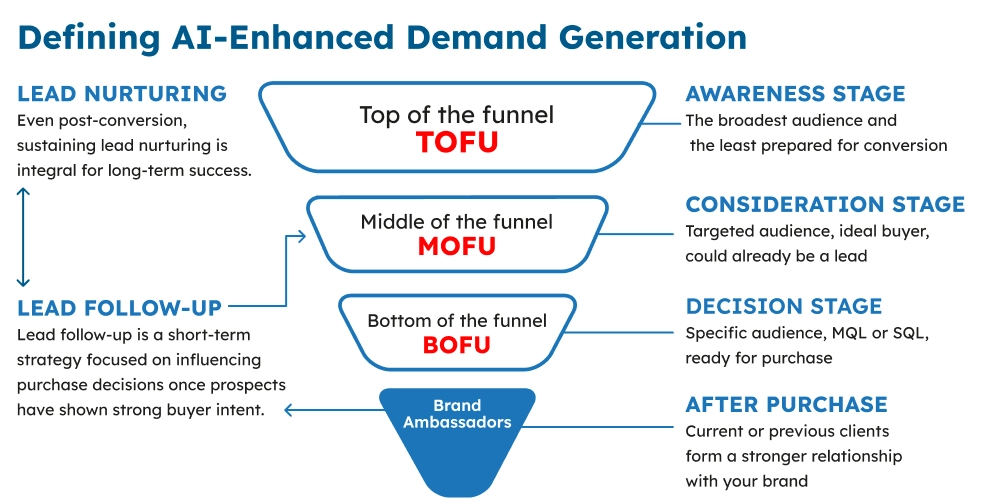Want to convert more B2B leads without being pushy?
This guide breaks down the 10 biggest mistakes marketers make in lead follow-up—and how to avoid them. With longer sales cycles, more stakeholders, and cautious buyers, success hinges on timing, personalization, and strategy.
Whether you’re nurturing warm leads or engaging decision-makers, this report gives you the tools to build trust, improve conversions, and drive long-term value.
What you’ll discover inside:
- Why lead follow-up is different from nurturing—and how to master both.
- How to build data-backed lead scoring systems that prioritize real intent.
- Tactics to align sales and marketing for more efficient handoffs and higher ROI.
- Multi-channel outreach tips that reduce fatigue and boost engagement.
- Real examples of personalized messaging, optimized content, and strategic pause points.
- AI insights for identifying high-value leads and creating tailored follow-up campaigns.
Perfect for BDRs, demand gen teams, and marketers working in complex buying environments.
Successful marketers have turned the skill of effectively following up on leads into the art of maintaining and increasing revenue. Vendors who know how to encourage conversions without being too assertive can easily maximize customer lifetime value (CLTV). And with the rise of B2B buying groups that typically involve four to ten decision-makers, sales cycles have been prolonged. As a result, detailed outreach strategies are now more important than ever. But beware, as you may encounter many pitfalls on your mission. Read on to avoid these 10 most common B2B customer outreach hurdles and guide prospective buyers down their purchasing journey.
The Essence of Lead Follow-Up in B2B
Lead follow-up is the process of reaching out to potential buyers who have shown interest in a brand, but have yet to make a purchase. This tendency is measured by the actions these parties have shown in the product/service. Business development representatives (BDRs) qualify the accounts based on several factors, such as whether they fit the ideal customer profile (ICP), needs, pain points, budget, etc. A BDR’s ultimate goal is to build trust and strengthen relationships with the executives they come in contact with to encourage them to move through the sales funnel and eventually make a purchase. Successful outreach is directly linked to higher client lifetime value, boosting retention, and brand advocacy. Keep reading for a full breakdown of how to master the art of prospect follow-through.
Understanding Lead Nurturing vs. Lead Follow-Up
The two strategies aim to guide potential buyers down your sales funnel, but they have different timings and come into play at separate stages of the buying journey. Look at this visual representation of the funnel, its three phases, and where prospect nurturing falls compared to customer outreach.

Because of the Great Tech Stall in the second half of 2023, buyers have taken a defensive stance. This trend has spilled over into 2024, leading to modest growth and somewhat reduced expectations (Forrester, 2023). The buying process has taken a hit in this downturn, and stakeholders are under pressure to deliver value and reach their business goals. And since the B2B buying journey is now longer and more complex, well-done follow-up strategies could prove to be the answer to all your efforts. So here are the ten most common mistakes to avoid when creating and implementing your customer outreach strategy.
1. Cracking the Code of Effective Lead Scoring
Never mix up your potential clients and leave them all in the same database “pile”. Businesses that take the time to categorize prospects into separate stacks based on how ready they are to make a purchase are better at customizing their lead scoring approach. Read on to explore lead scoring in detail and to get a complete overview of how to improve data management.
Lead Categorization Overview
Hot Leads
High
Potential customers who are ready to make a purchase based on their score and general activity.
Warm Leads
Medium
Prospective clients who have shown interest and buyer intent but do not meet the threshold to be categorized as ready to buy.
Cold Leads
Low
Contacts that have failed to indicate any intent toward making a purchase despite marketing efforts. They could be a poor fit for the brand.
Make sure you consider the following:
It’s important to avoid picking and choosing leads, as this can result in promising opportunities not being taken advantage of. Effective B2B client relationship building is crucial for generating demand and encouraging decision-makers to move closer to a purchase. When deciding on the best approach for following up with promising accounts, use lead scoring data, buyer personas, Ideal Customer Profiles (ICPs), and any other available intelligence. This may include information about purchasing behavior and other influential factors that could affect how prospects respond to sales strategies.
2. Leveraging Data Updates for Effective B2B Outreach
Remember to use the latest contact information you have. Make sure to update your database regularly. Your strategies will need to change as market trends and buyer behavior change. So, reviewing and updating how you assess B2B marketing leads is essential. This will help you adjust your strategies more accurately to deal with any challenges and changes that come up. Here are some examples of how to update your database in order of detail level:
ICPs
Firmographic and demographic data listing the technology stack commonly used by businesses likely to be interested in your solutions.
Company size
Industry
Budget
Job Title
Tech Stack
By meticulously updating and maintaining the data within your Ideal Customer Profiles (ICPs), Buyer Personas, and Lead Intelligence tables, you lay a robust foundation for efficient data segmentation. This detailed information empowers you to categorize lists effectively based on their firmographic, demographic, and behavioral attributes. Such segmentation facilitates tailored and personalized follow-up campaigns that resonate with each segment’s specific needs and preferences.
Buyer Personas
Detailed data on decision-makers at target accounts, including roles, challenges, and insights. Background info, demographics, and communication preferences for tailored outreach. Identification of objections and barriers to purchase for proactive sales strategies.
Professional Information
Values and Goals
Personal Background
Identifying Information
Objections and Barriers
For instance, with clear insights into company size, industry, budget, job titles, and tech stack from your ICPs, you can precisely target leads that align with your ideal customer profile. Similarly, by understanding the professional information, values, goals, personal background, and objections of buyer personas, you can craft messaging and content to address their pain points and aspirations directly.
Lead Intelligence
Insights into preferred marketing channels and messaging strategies that drive high engagement and conversion rates among potential clients.
Marketing Channel Preferences
Top Performing Messaging
Top Engagement Drivers
Moreover, leveraging lead intelligence such as marketing channel preferences, top-performing messaging, and top engagement drivers enables you to optimize your outreach efforts. You can channel resources into the most effective channels and refine messaging to align with what resonates most with your promising contacts. Focus on engagement drivers that yield the highest response rates.
Ultimately, by ensuring data efficiency across these tables, you gain the ability to segment accounts as needed, informing the customization and performance of your lead follow-up campaigns. This strategic approach enhances the relevance and effectiveness of your outreach efforts, resulting in improved conversion rates and stronger customer relationships.

3. Shift Selling Tactics from Urgency to Relationship Building
Creating a sense of urgency is no longer effective when dealing with today’s defensive buyers. Rushing a prospect toward a sale before they are ready or able to do so will not only result in churn, but also damage any trust established through demand generation efforts. Instead, it’s better to build a stronger relationship with contacts to lay the foundation for lead follow-up and other outreach strategies. In addition to lead nurturing, here are two other approaches to consider: